Tele Vue Eyepieces in Irish Skies
Pat Rochford has made the trip from Alabama to Ireland for most of his life. This time he brought along a telescope and Tele Vue eyepieces. In this guest blog post, he tours Ireland with an eye on the sky. (Unless otherwise noted, all images copyright by the author and used with permission.)
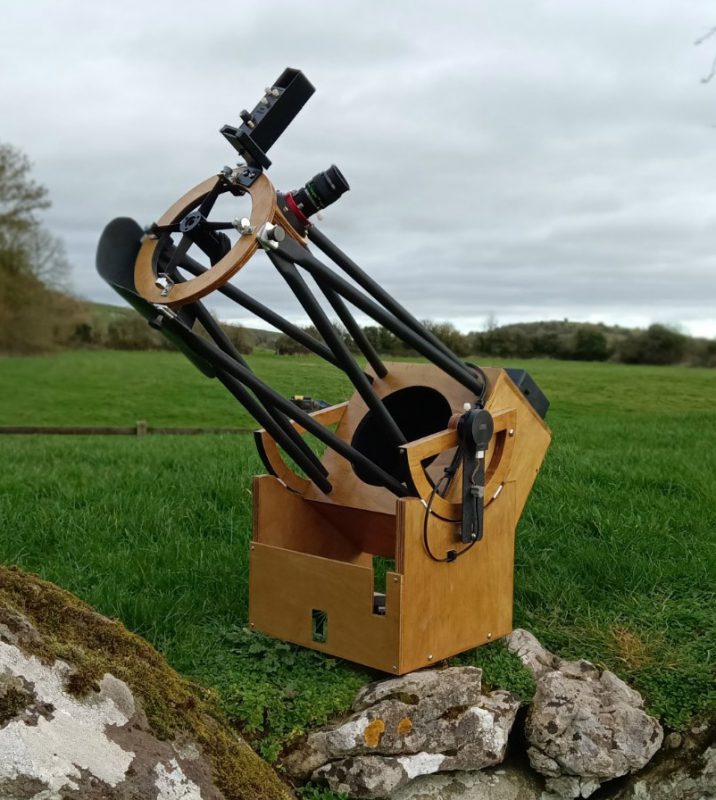
I’ve been traveling to Ireland for more than forty years, but always for relatively short stays and only in the warmer months. These visits have fed a passionate desire to know the land of my ancestors but did little to satisfy my other obsession: stargazing. Because of its location in the upper northern latitudes, astronomical darkness in the summer months doesn’t come until nearly midnight. And the night sky itself is rather fleeting, as dawn comes with a fury in just a few short hours.
This year (2023) things changed for me in the form of retirement. No longer at the beck and call of an employer, I was free to return to the Emerald Isle for a lengthy period and at a time of the year when the nights are quite long. On January 17th my wife, Stephanie, and I departed the Alabama Gulf Coast for the west of Ireland, near the tiny town of Kilshanny in County Clare. A two-hundred-year-old cottage, less than three miles from the Atlantic Ocean, would be our home for the next nine weeks.
Multiple, clear winter nights anywhere in the world are certainly not guaranteed, especially in northern Europe. But we amateur astronomers are a determined breed and are not put off by these odds. With this mindset, I decided to take the challenge a step further and build a telescope specifically designed for this trip. I wanted to bring the largest scope possible that would fit in the overhead compartment of a commercial airliner, since bringing one as ‘checked baggage’ is a recipe for disaster.
Delta Airlines allows a maximum ‘carry-on’ size of 22”x14”x9”, so this would determine just how large of a telescope I would be bringing. By using removable truss tubes I could eliminate a solid tube, thus allowing a larger objective than say 4 or 5 inches. Calculations on the back of a few cocktail napkins indicated that a 6” f/5 Dobsonian would be possible. The first build would be a case made to the above (outside) dimensions, using ¼” plywood. I would have to fit everything required (eyepieces, Barlows, filters, finder, digital setting circles w/optical encoders, brackets and wiring harness, light shield as well as all the scope components and associated hardware) into this case.
The first image shows the finished scope and rocker box unassembled along with the Tele Vue 24mm Panoptic, 11mm Nagler Type-6, 7mm Nagler, Tele Vue 3x and 2.5x Barlows, plus 1.00 DIOPTRX astigmatism corrector used on the trip. The second image shows the 6″ Dobsonian in its travel case. The final image shows the travel case and backpack on a luggage dolly.
The inside long dimension of the case measured 21½”, so the length of the eight truss tubes would need to be cut to 21”. The mirror box would have to make up the remaining distance (to accommodate the focal length of the primary), so the height of this box became 7½”. With the other two dimensions being 11”x11”, this would become the largest single component. The rocker box would have to break down into multiple pieces, the altitude bearings would need to be removable and the upper cage assembly would need to be a single ring. In the classifieds, I found a primary mirror with a cell as well as a secondary and spider. I found and ordered a new 1¼” helical Crayford focuser. Construction was slow and deliberate as each piece had to be made so that it would fit within the confines of this case.
Okay, so what does all of this have to do with Tele Vue Optics? It has a substantial amount to do with the final image of the objects I’ll be hunting in the inky dark skies of rural western Ireland. Breathtaking images are why so many of us spend the extra money it takes to own these amazing designs from Chester, NY. All of my twenty-one eyepieces and Barlows are Tele Vues. The Plössls, Radians, Panoptics, Delos, Naglers, and Ethos all demonstrate the creative brilliance of Al Nagler and the late Paul Dellechiaie. With such a large number of choices, it was easy to pick a set to take with me covering a range of magnifications and exit pupils.
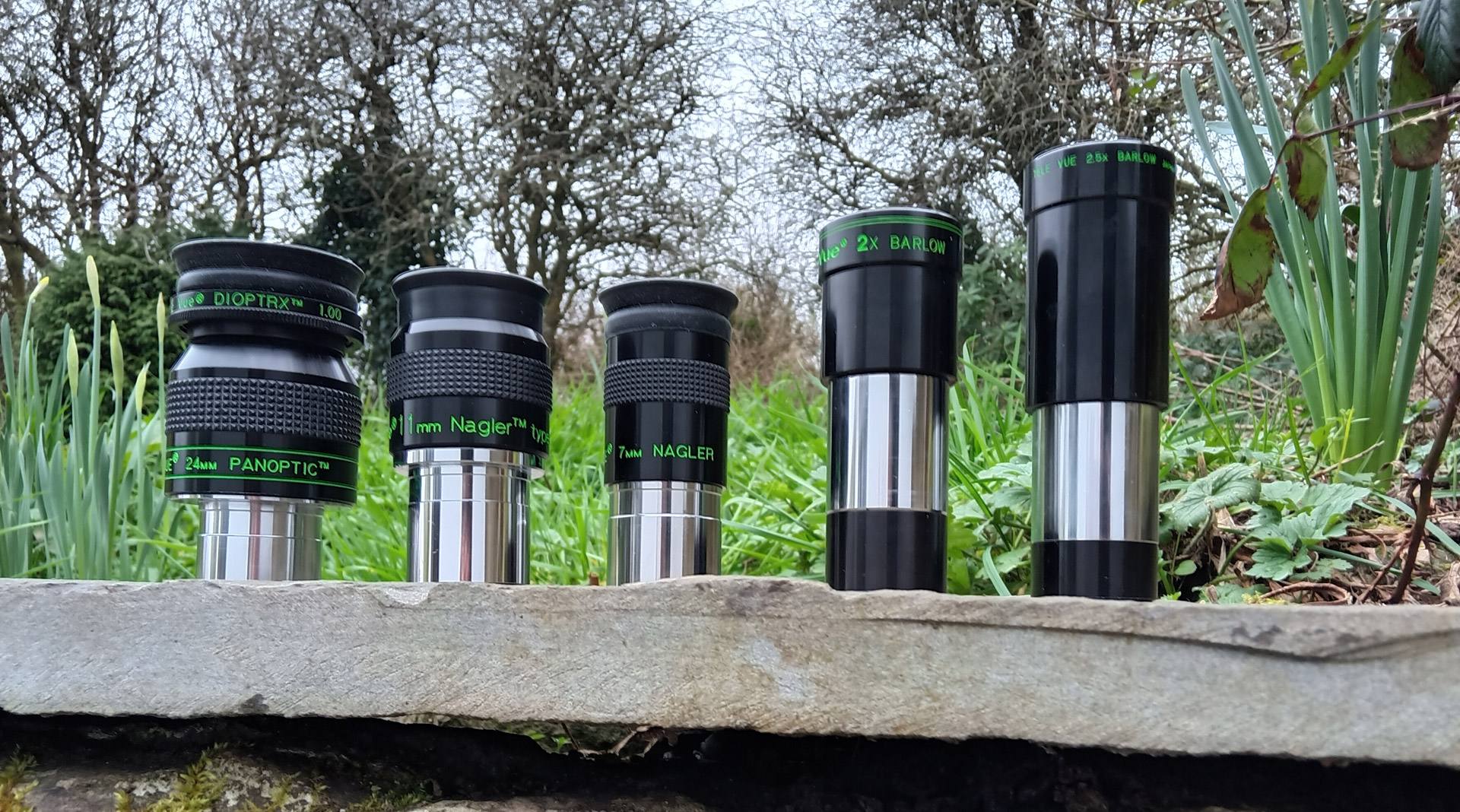
For low power, my 24mm Panoptic provides a magnification of 31x, an exit pupil of 4.8mm, and a true field of view of 2.1°. A 1.00 Dioptrx cleans up issues with my old eyeballs to make this wide view incredibly sharp. Next, an 11mm Nagler Type-6 at 68x followed by my original 7mm Nagler at 107x. Using 2x and 2.5x Barlows, the 11mm and 7mm Naglers provide magnifications of 136x, 170x 214x and finally topping out at 267x.
Over a period of 61 nights in Ireland, 13 of them produced clear skies that allowed observing for at least an hour or two. This equates to 21% overall. Not bad considering the location is in northern Europe in the dead of winter. I doubt conditions would have been much improved back home on the Gulf Coast. Nights that were free of any Moonlight were phenomenally dark and transparent. The following are portions of my recorded observations, using a reasonably large ‘airline transportable’ scope, top-of-the-line eyepieces, and what’s left of my 68-year-old eyes.
January 18th
This was officially our first night there … and clear. I’d been up for close to 48 hours but was mostly able to reconstruct the 6” and collimate it. However, carrying it outside and placing it on a picnic table afforded me the opportunity to discover just what the combination of below-freezing temps and near exhaustion can do to one who hails from a semi-tropical climate. A voice in my head kept telling me hypothermia was a given under these circumstances and so I decided to call it a night.
January 19th
I was well rested and dressed for the occasion and the night sky was once again very clear and transparent. The combination of more stars visible as compared to my skies back home along with a difference in latitude of a bit over 23° made finding my way around a tad clumsy. I knew Polaris would be higher up, but actually experiencing it is quite another thing. Nevertheless, the Sky Commander digital setting circles were accurate on the first try. M1 (Crab Nebula) is the default object and since it was in a good position I pushed the scope around as directed by the numbers on the softly glowing screen. M1 is not the brightest target to test accuracy so I was prepared to spend a few minutes looking with averted vision to find it. But there it was, centered in the Tele Vue 24mm Panoptic eyepiece – with direct vision. After taking a few minutes to check out the quality of the outer field of view (spectacular even without a coma corrector) I removed the Panoptic and placed the 11mm Nagler Type-6 in the focuser. The supernova remnant now displayed ‘shape’. It wasn’t long after that I replaced this eyepiece with the 7mm Nagler. The shape now began to show variations in brightness along its edges. Nothing in the way of filamentary structure that I had seen in my 24” scope years ago, but certainly a tease of something a bit beyond the capability of this aperture. The seeing was not great, so additional magnification didn’t add anything significant. I remembered that M1’s nickname is the Crab Nebula. It was given this moniker in 1844 by the 3rd Earl of Rosse, who by the way, lived about 60 miles from where I’m presently observing it.
January 25th
After a few nights clouded out, today began with clear skies and they held until dark. The prime target tonight is Comet C/2022 E3 (ZTF), now located in Ursa Major and expected to be at its brightest (magnitude 5.5 or so) for the next couple of days. By 10 pm it is well placed above the horizon and using the chart from an issue of Sky & Telescope I am easily able to locate it, as it’s just detectable without optical aid. In the 24mm Panoptic it is a very respectable comet. Not the caliber of Neowise in 2020, but well worth the time taken to find it. It’s fairly large with a bright nucleus and is fan-shaped but I can’t detect any tail with either the Panoptic or the 11mm Nagler Type-6, and I don’t see any green color as has been described by some. Perhaps the color is only seen in images. At this time I’m unable to detect any movement among the stars in a matter of a few minutes of time.
I also took advantage of tonight’s darkness (after the crescent Moon set) to locate a few of the spiral galaxies first observed by the 3rd Earl of Rosse with his 72” Newtonian at Birr Castle (not far from here) in the 19th century. M51 (Whirlpool Galaxy) was the first to show its spiral shape, in 1845. Tonight I located it using the 11mm Nagler Type-6 (68x). I could easily make out both M51 as well as its very close companion, interacting dwarf galaxy NGC-5195. Upping the magnification to 107x (7mm Nagler) the gap between them became more apparent, but I saw no sign of the connecting bridge. At 136x (11mm Nagler Type-6 with Tele Vue 2x Barlow), I might have seen just the slightest hint of separation from the center of this galaxy using averted vision. Knowing what to look for is a huge help but I’m not totally confident I saw this. If I were looking for the first time I would most certainly have missed this. I then input M101 (Pinwheel Galaxy) into the Sky Commander and followed the descending numbers to its location. Under these sky conditions, it should be a relatively easy target. To my surprise though, I saw nothing. Not even any stars. Looking up from the eyepiece explained why. In a matter of a couple of minutes, the sky had completely clouded over. The Atlantic it seems can turn a good night into a bad one in the blink of an eye.
(left) One of the eyepieces from Lord Rosse’s 72″ telescope at Birr Castle. “It literally dwarfs my 31mm Nagler”, says Pat. (right) Drawing of M51 by William Parsons using the 72″ telescope. (Public domain image.)
January 27th
The Moon has reached first-quarter so deep sky observing is taking a backseat to our closer neighbors. Jupiter and Mars are in a good position for observing except they are now much lower in the sky up here at 53° north latitude. And the jet stream, which normally leaves those of us nearer the equator alone, has elected to pick a fight with me here tonight. At any magnification, these two planets are simply quivering blobs. Even the Moon, which can tolerate relatively poor seeing, is a lost cause.
February 4th
A full Moon, the Snow Moon, was a night made for looking at Lunar rays. At 31x in the 24mm Panoptic, Tycho and Copernicus scream for attention. It’s difficult to imagine the forces that caused this much debris to be flung so far from the location of each impact. Next, in spite of the full Moon, I decided to make one more attempt to see Comet ZTF before it fades too much on its way back to the Oort Cloud. The Sky &Telescope chart indicates that it has now scooted well past Capella. The 24mm Panoptic, with its two-plus degree true field of view, makes for a very capable finder-eyepiece. After panning in the expected area for a few minutes I find the comet, considerably fainter than when last observed ten days ago. The glare from the Moon obviously doesn’t help matters either. I replaced the Panoptic with the 11mm Nagler Type-6 and eventually, the 7mm Nagler to aid in gaining better contrast. ZTF still shows its wedge shape and now having a background star relatively close to it I am able to detect movement relative to this star after about ten minutes. Note: I was also able to get one final view three nights later.
February 13th
I woke up well before daylight, peeked out the window, and saw stars. Most mornings here have been overcast, so I decided to take advantage of the situation. I carried the 6” outside, placed it on the picnic table to cool down, and looked directly overhead. There was Ursa Major in a perfect position to continue my quest to locate and observe a few of the galaxies that gave up their spiral shape to Lord Rosse’s giant reflector so many years ago. I began again with M51, using the 7mm Nagler at 107x. Moving to 136X in the Barlowed 11mm Nagler Type-6, the view was very similar to that of Jan 25th. This time, using averted vision, I could just make out a portion of the spiral band on the side of the galaxy furthest from NGC-5195. Nothing in way of the other band though. I’m certain this must be close to the limit for a 6” objective, but the conditions this morning were exceptional. M51 was directly overhead in the darkest sky I may have ever experienced, along with very steady seeing. In my larger instruments, seeing spiral structures in this galaxy has been fairly common, even in less-than-ideal conditions. The view this morning in a relatively small instrument has felt like quite an accomplishment, owing to both exceptional local conditions as well as expertly designed and executed optics such as the Tele Vue eyepieces in my kit.
Continuing on the spiral tour, M101 was next on my list. The view of this face on spiral was best shown in the 11mm Nagler Type-6 at 68x. Although the complete extent of these pinwheel arms is not seen, even with averted vision, enough of it is. Moving the scope back and forth slightly helps to differentiate between the galaxy and the dark background of the sky. Having observed this galaxy in larger scopes, I can mentally connect the missing areas, so to speak, and envision what it actually looks like. The final three spirals on my list were NGC-3631, NGC-4151, and NGC-4725. I located all of these, but try as I may any evidence of spiral structure was simply beyond the light grasp of my 6”. I would have to take the word of the Earl that these faint fuzzies were in fact island universes with pinwheel structures.
The day dawned clear and remained so after sunset. By the time it became completely dark, the wind had subsided leaving a striking stellar canopy overhead. The Hyades and Pleiades clusters were very prominent with the winter Milky Way simply stunning as it arched across the sky at the beginning of another inky black night. Stephanie joined me at the telescope as I centered the Double Cluster in the 24mm Panoptic. Clusters NGC-884 & NGC-869 became almost lost in the background Milky Way. With the Dioptrx, the hundred-plus stars captured in this view were pinpoints from one side to the other. The capability of a 6” f/5 scope, partnered with this particular eyepiece, proves its capability as a Richest Field Telescope. It was hard to determine which was more mesmerizing – the view in the eyepiece or the view of the entire sky without any optical aid. The Universe put on one of its best shows ever on this quiet night in the west of Ireland.
(1st image) The 6″ f/5 Dobsonian is photographed inside the Grange Stone Circle in County Limerick. (2nd image) Comprised of 113 contiguous standing stones, the structure dates to around 2,200 BC. The entrance stones match with slabs in a V-shape on the southwest side, which align with sunset on the Celtic festival of Samhain in early November. Thus the Grange Stone Circle is an astronomical tool just like the 6″ Dobsonian.
February 22nd
The temperature this night was just barely above freezing, with a slight but steady breeze off the Atlantic. Bad in that it required frequent trips inside for hot tea but good in that the dew would hold off for a longer time. Spiral Galaxy M74 was the first object of the night, located as soon as the waxing crescent Moon dipped below the hill behind our cottage. Next, M97 the Owl Nebula, was a nice treat in the 11mm Nagler Type-6 with an OIII filter. The eyes were ‘kind of’ there with averted vision. This was one of those occasions where you sort of have to convince yourself that’s what you were seeing.
There was no head-scratching in the next view though, as the galaxies M81 (Bode’s Galaxy) and 82 (Cigar Galaxy) were an absolutely stunning pair, bright and hovering with an almost 3D effect in the 24 Panoptic. No averted vision was needed here. At higher magnifications, each showed details that kept me glued to the eyepiece. Or was my eye actually frozen to the Nagler? It could have been a bit of both I suppose.
Leo, now high enough for exploring, occupied the next observing period between trips to the tea kettle. The Leo Triplet galaxies – M65, 66, and NGC-3628 – signal to me the approach of Spring and galaxy season. They’re bright enough to show some detail in a scope this size, particularly so in dark skies such as what I’m experiencing from this location. Moving in the general direction of Regulus, I find similar treasures: galaxies M95, M96, M105, and NGC-3384. In the haunches of Leo, a myriad of faint galaxies can be found, but dew is beginning to find its way to the secondary mirror, making the challenge of finding these in my ‘less than large’ instrument beyond reach. And of course, there’s the desire to save my fingers and toes from permanent frostbite damage as well, so I’ve decided to quit while I’m ahead.
February 24th, 25th and 26th
We’re attending a traditional Irish music festival this weekend in the nearby coastal town of Doolin. (My telescope remains back at the cottage, taking a well-deserved rest.) The skies remain clear though and put on quite a show each evening as a waxing crescent Moon, Venus and Jupiter put on a continually moving display. The backdrop to this show is the Cliffs of Moher, towering 700 feet above the crashing waves of the Atlantic Ocean. More unforgettable sights on this incredible trip.
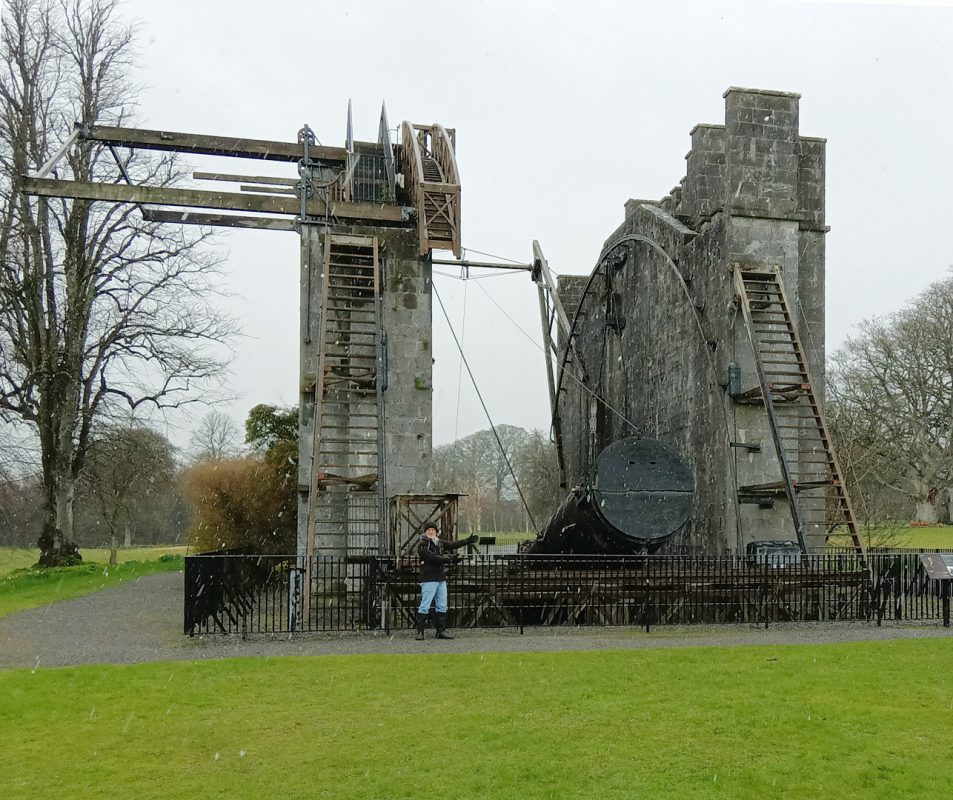
William Parsons, 3rd Earl of Rosse, built several scopes in the 19th Century on his property at Birr Castle in County Offaly, Ireland. The Leviathan of Parsonstown reflector, photographed here, was his largest with a 72-inch (6 feet) aperture and 52-foot tube. It was the world’s largest aperture telescope from 1845 to 1917 when the 100-inch Hooker Telescope surpassed it. This Newtonian is mounted to view objects within the vicinity of the meridian. For objects at high elevation, a curved wooden gallery on the top of the western (left) tower is designed to allow observation through the eyepiece. For lower-elevation objects, an observing cage (seen near ground-level in front of the western tower) can move up and down and between the towers.
March 9th
It’s snowing and we are in the town of Birr in County Offaly. Birr Castle is the home of the Third Earl of Rosse and the location his 72” telescope. Although not operational anymore, it was the largest telescope in the world from 1845 to 1917. This is the third time I’ve visited this site (also in 1995 and 2005) and each time it continues takes my breath away. It is here that M51 became the first galaxy to show spiral structure. Lord Rosse (William Parsons) was the consummate amateur astronomer. He designed, funded, built, and observed with this incredible telescope until his death in 1867. New since my last visit, is a science center on the grounds containing artifacts from this and earlier telescopes he built along with some of his original drawings of the spiral nebulae observed with the 72”. One of the displays contains a brass eyepiece that literally dwarfs my 31mm Nagler.
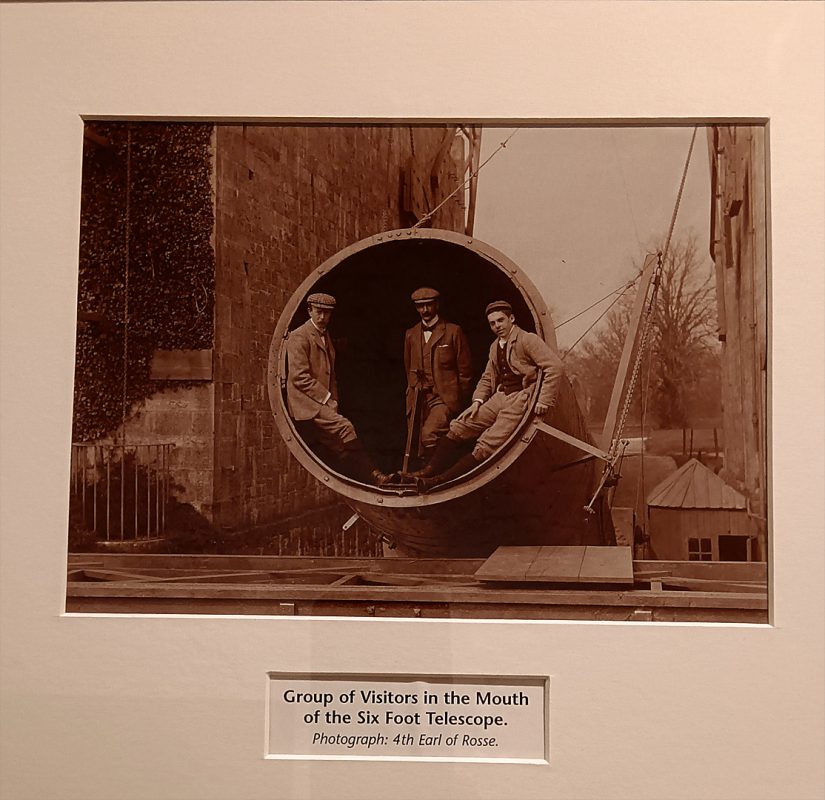
March 13th
Back in Leo again, on another shivering evening with perfect skies. And once again the 24mm Panoptic at 31x, a true field of 2.1° and an exit pupil of 4.8mm, is the perfect eyepiece for hunting down galaxies. The eye relief is very accommodating, making for one of the most comfortable eyepieces in my possession. For zooming in a bit on galaxies the 11mm Nagler Type-6, with an exit pupil of 2.2mm, is the perfect match for maximum resolution with my eye. I could have continued all night if it weren’t for the fact that I couldn’t feel any of my extremities after about three and a half hours. Ah … to be young again.
March 18th
This would be the last clear night, but my telescope had been packed and readied for the return flight in a couple of days. Not to waste it though, I spent an hour with just my eyes, taking in this brisk, ultra-dark, crystal-clear sky with a slight scent of the Atlantic, just one more time.
Did you observe, sketch, or image with Tele Vue gear? We’ll like your social media post on that if you tag it #televue and the gear used. Example:
72inch Newtonian #televue #nagler #m51
Do you want your Tele Vue images re-posted on Tele Vue Optics’ Social Media accounts? Use this hashtag for consideration:
More Info
- Why Choose Tele Vue Eyepieces and on the mobile site
- Tele Vue Eyepiece Specifications and on the mobile site
- Tele Vue Eyepiece Calculator and on the mobile site
- Video: Tele Vue Eyepiece Quality Controls and Tolerances



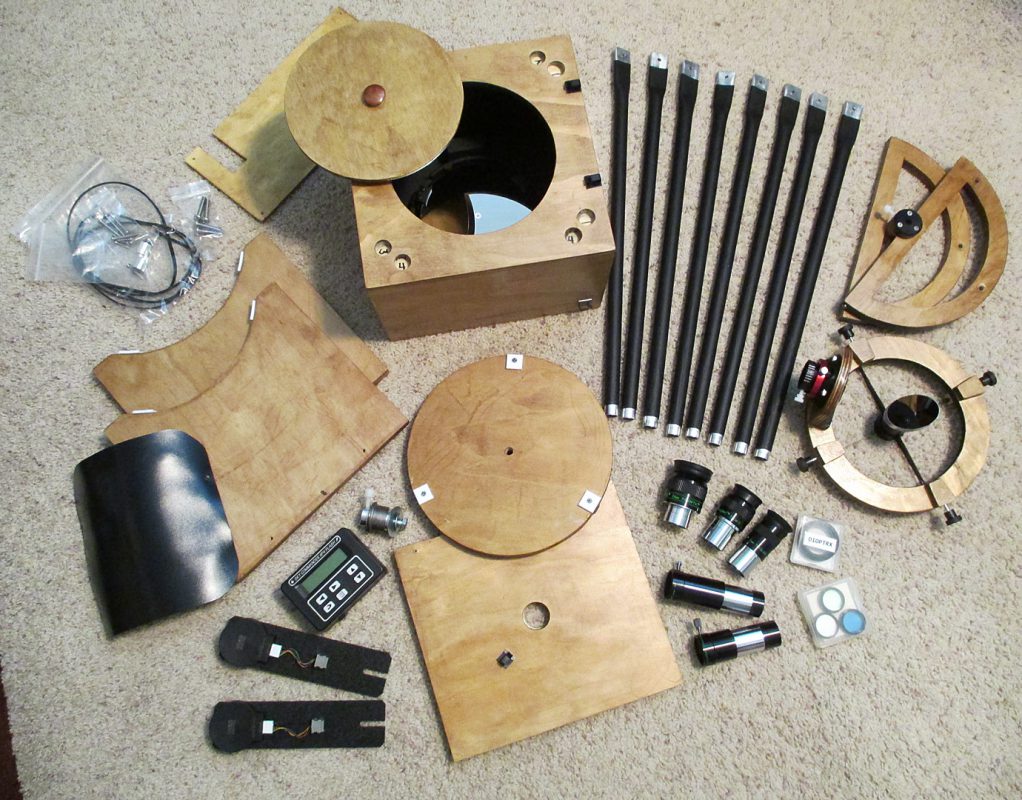
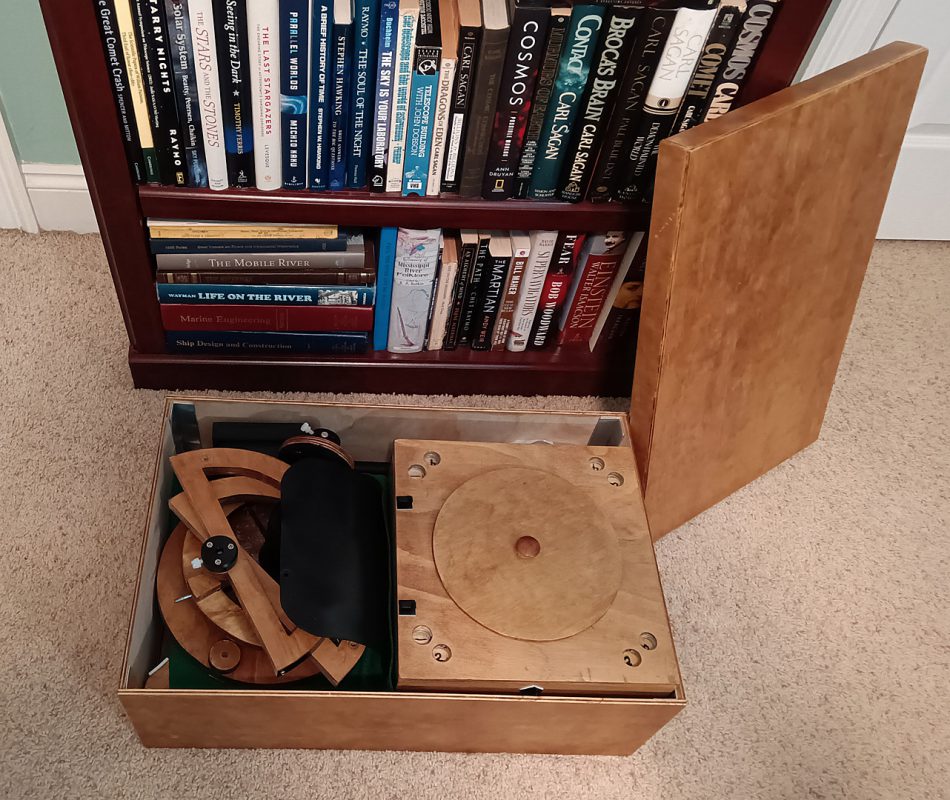
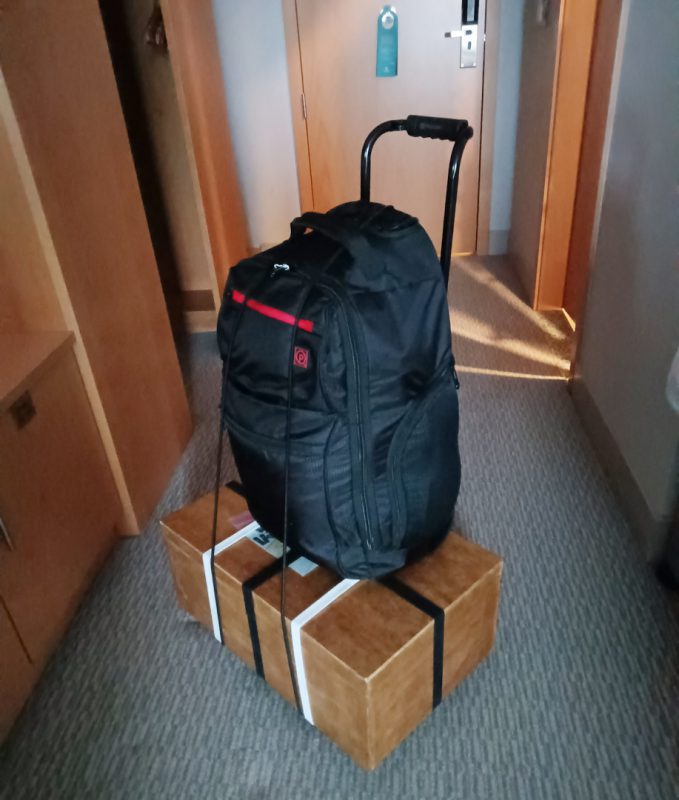
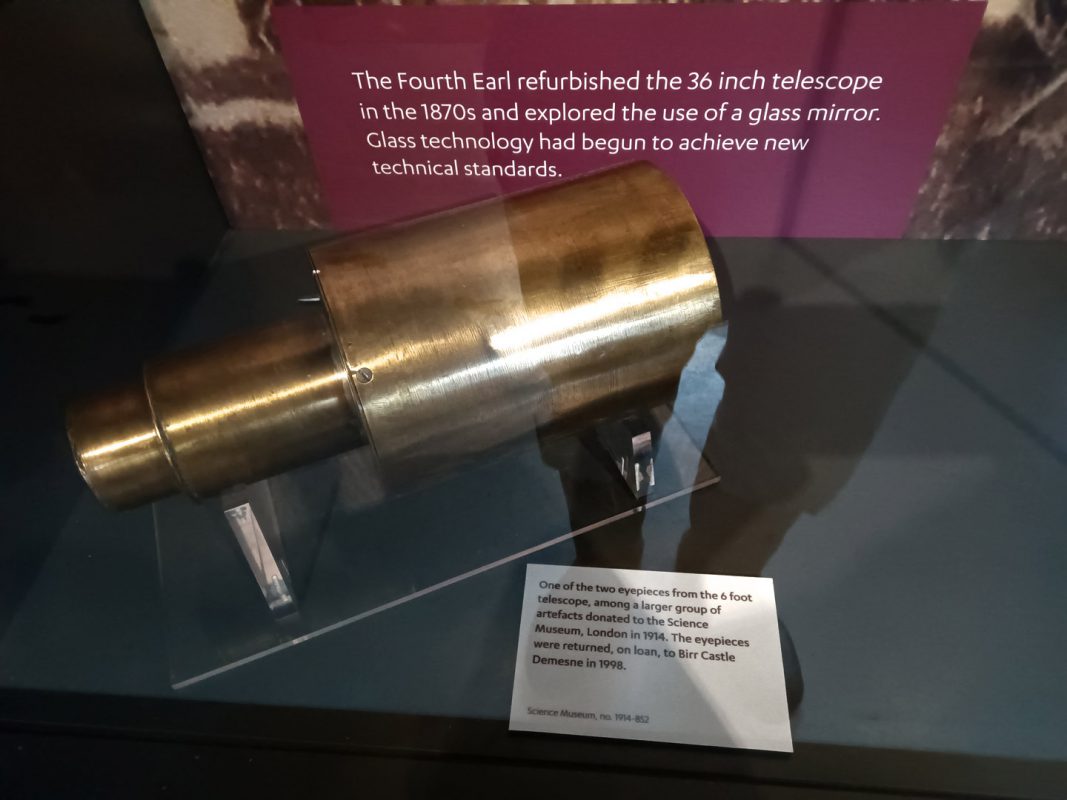

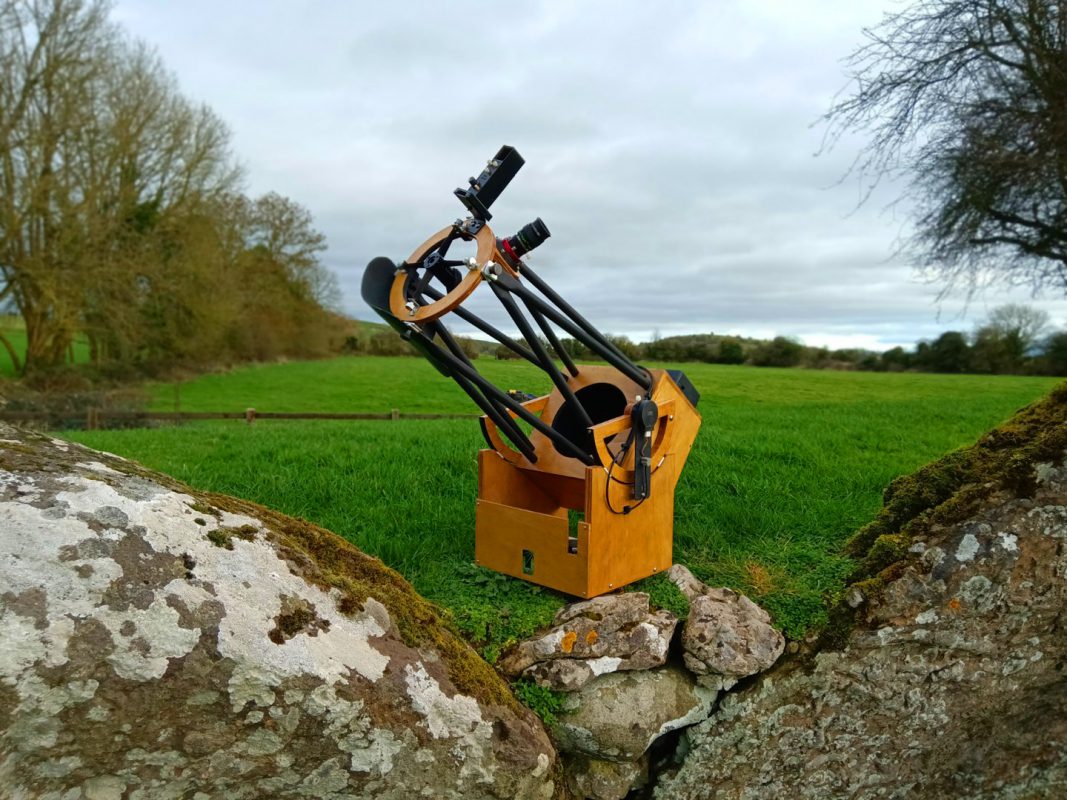
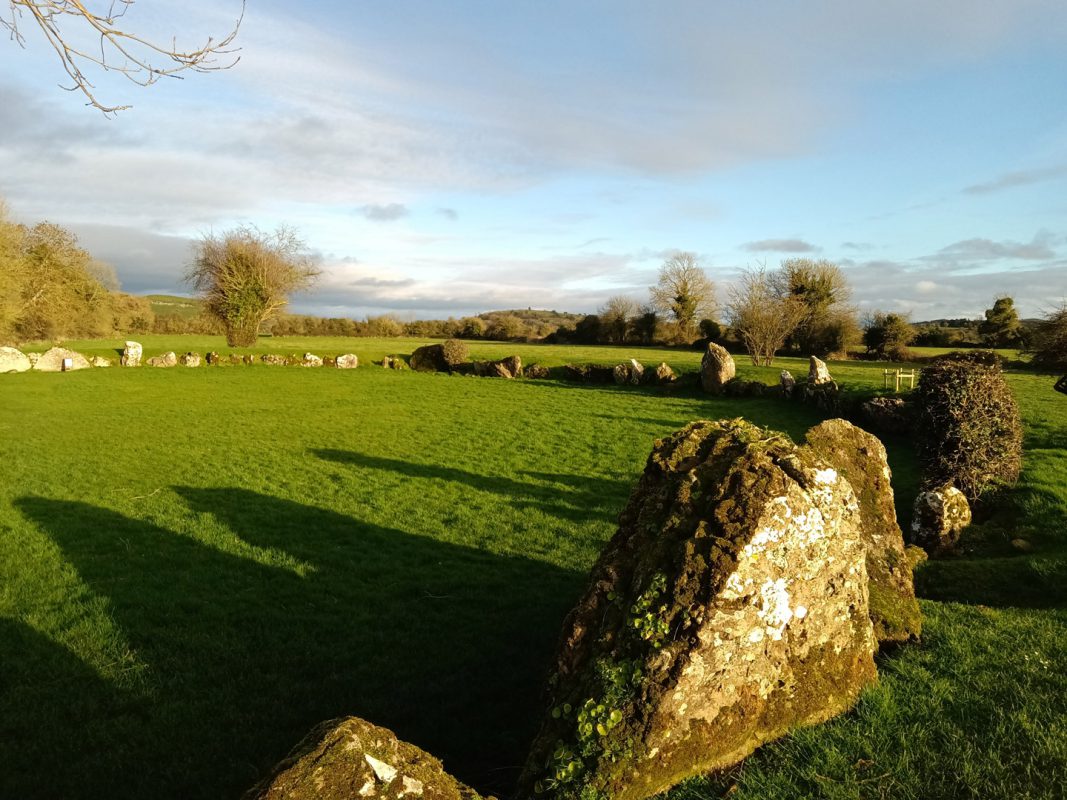

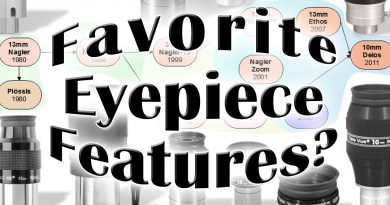
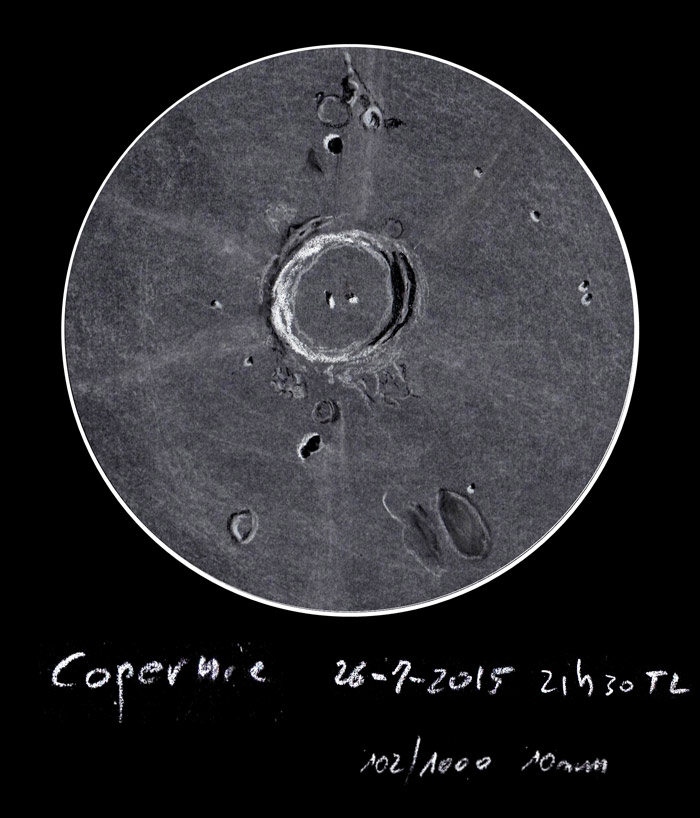
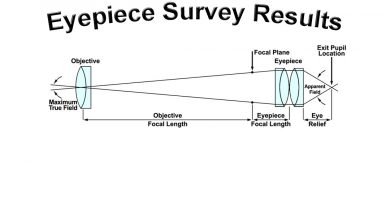
Thanks, wonderful descriptions .
Heineken on an Irish pub?? Sacrilege! (and it’s a bigger sign than Guinness!). Horrors…
Love the pictues: 72″ @ Birr, & the 3 blocs standing inside the 72″ barrel!
–rfm
Thanks for the compliment, Michael. Adjectives come easily under these kinds of skies.
rfm – I never actually saw anyone in the pub drinking Heineken. If there were such a person partaking of this particular brew, they must have been out back. In a sea of black pint glasses, something with an amber tint would stand out like the proverbial sore thumb. So when in Rome, err Doolin rather, …
The first thought that comes to mind when looking up at the 72″, is how it must feel to be precariously perched waaaay up there. It’s the middle of the night, it’s dark as the inside of a cow and leaning out a bit too far is tantamount to being granted ‘eternal reward’ somewhat earlier than one might wish.
In contemplating the anxiety that this height issue must bring on, it might just answer the question of why a wagon full of oak barrels from Dublin was seen pulling up to Birr Castle several times a week.
Pat Rochford